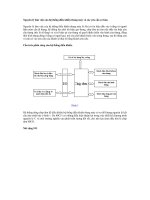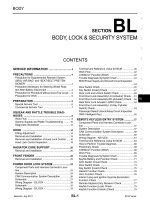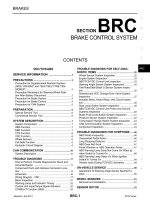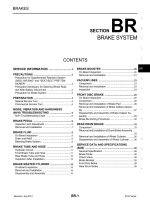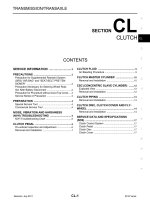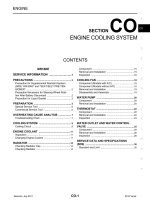BRC hệ THỐNG điều KHIỂN THẮNG NISSAN VERSA HATCH BACK 2012
Bạn đang xem bản rút gọn của tài liệu. Xem và tải ngay bản đầy đủ của tài liệu tại đây (1.83 MB, 57 trang )
BRC-1
BRAKES
C
D
E
G
H
I
J
K
L
M
SECTION BRC
A
B
BRC
N
O
P
CONTENTS
BRAKE CONTROL SYSTEM
VDC/TCS/ABS
SERVICE INFORMATION
3
PRECAUTIONS 3
Precaution for Supplemental Restraint System
(SRS) "AIR BAG" and "SEAT BELT PRE-TEN-
SIONER"
3
Precaution Necessary for Steering Wheel Rota-
tion After Battery Disconnect
3
Precaution for Brake System 4
Precaution for Brake Control 4
Precaution for CAN System 5
PREPARATION 6
Special Service Tool 6
Commercial Service Tool 6
SYSTEM DESCRIPTION 7
System Component 7
ABS Function 7
EBD Function 7
TCS Function 8
VDC Function 8
Wheel Sensors 8
Fail-Safe Function 8
Hydraulic Circuit Diagram 9
CAN COMMUNICATION 10
System Description 10
TROUBLE DIAGNOSIS 11
How to Perform Trouble Diagnosis for Quick and
Accurate Repair
11
Component Parts and Harness Connector Loca-
tion
14
Schematic 16
Wiring Diagram - VDC - 17
Basic Inspection 21
Warning Lamp and Indicator Timing 22
Control Unit Input/Output Signal Standard 22
CONSULT Function (ABS) 25
TROUBLE DIAGNOSIS FOR SELF-DIAG-
NOSTIC ITEMS
32
Wheel Sensor System Inspection 32
Engine System Inspection 33
ABS/TCS/VDC Control Unit Inspection 33
Steering Angle Sensor System Inspection 34
Yaw Rate/Side/Decel G Sensor System Inspec-
tion
35
Solenoid and VDC Change-Over Valve System
Inspection
37
Actuator Motor, Motor Relay, and Circuit Inspec-
tion
38
Stop Lamp Switch System Inspection 39
ABS/TCS/VDC Control Unit Power and Ground
Systems Inspection
40
Brake Fluid Level Switch System Inspection 41
Pressure Sensor System Inspection 42
Transmission Range Switch System Inspection 43
CAN Communication System Inspection 44
Component Inspection 44
TROUBLE DIAGNOSES FOR SYMPTOMS 46
ABS Works Frequently 46
Unexpected Pedal Action 46
Long Stopping Distance 47
ABS Does Not Work 47
Pedal Vibration or ABS Operation Noise 47
ABS Warning Lamp Does Not Come On When Ig-
nition Switch Is Turned On
48
ABS Warning Lamp Stays On When Ignition
Switch Is Turned On
48
Vehicle Jerks During TCS/VDC Activation 49
ON-VEHICLE SERVICE 50
Adjustment of Steering Angle Sensor Neutral Po-
sition
50
WHEEL SENSORS 51
Removal and Installation 51
SENSOR ROTOR 53
Revision: July 2011 2012 Versa
BRC-2
Removal and Installation 53
ACTUATOR AND ELECTRIC UNIT (ASSEM-
BLY)
54
Removal and Installation 54
STEERING ANGLE SENSOR 56
Removal and Installation 56
YAW RATE/SIDE/DECEL G SENSOR 57
Removal and Installation 57
Revision: July 2011 2012 Versa
PRECAUTIONS
BRC-3
< SERVICE INFORMATION >
[VDC/TCS/ABS]
C
D
E
G
H
I
J
K
L
M
A
B
BRC
N
O
P
SERVICE INFORMATION
PRECAUTIONS
Precaution for Supplemental Restraint System (SRS) "AIR BAG" and "SEAT BELT
PRE-TENSIONER"
INFOID:0000000007328907
The Supplemental Restraint System such as “AIR BAG” and “SEAT BELT PRE-TENSIONER”, used along
with a front seat belt, helps to reduce the risk or severity of injury to the driver and front passenger for certain
types of collision. This system includes seat belt switch inputs and dual stage front air bag modules. The SRS
system uses the seat belt switches to determine the front air bag deployment, and may only deploy one front
air bag, depending on the severity of a collision and whether the front occupants are belted or unbelted.
Information necessary to service the system safely is included in the SRS and SB section of this Service Man-
ual.
WARNING:
• To avoid rendering the SRS inoperative, which could increase the risk of personal injury or death in
the event of a collision which would result in air bag inflation, all maintenance must be performed by
an authorized NISSAN/INFINITI dealer.
• Improper maintenance, including incorrect removal and installation of the SRS, can lead to personal
injury caused by unintentional activation of the system. For removal of Spiral Cable and Air Bag
Module, see the SRS section.
• Do not use electrical test equipment on any circuit related to the SRS unless instructed to in this
Service Manual. SRS wiring harnesses can be identified by yellow and/or orange harnesses or har-
ness connectors.
PRECAUTIONS WHEN USING POWER TOOLS (AIR OR ELECTRIC) AND HAMMERS
WARNING:
• When working near the Airbag Diagnosis Sensor Unit or other Airbag System sensors with the Igni-
tion ON or engine running, DO NOT use air or electric power tools or strike near the sensor(s) with a
hammer. Heavy vibration could activate the sensor(s) and deploy the air bag(s), possibly causing
serious injury.
• When using air or electric power tools or hammers, always switch the Ignition OFF, disconnect the
battery, and wait at least 3 minutes before performing any service.
Precaution Necessary for Steering Wheel Rotation After Battery Disconnect
INFOID:0000000007798355
NOTE:
• This Procedure is applied only to models with Intelligent Key system and NATS (NISSAN ANTI-THEFT SYS-
TEM).
• Remove and install all control units after disconnecting both battery cables with the ignition knob in the
″LOCK″ position.
• Always use CONSULT to perform self-diagnosis as a part of each function inspection after finishing work. If
DTC is detected, perform trouble diagnosis according to self-diagnostic results.
For models equipped with the Intelligent Key system and NATS, an electrically controlled steering lock mech-
anism is adopted on the key cylinder.
For this reason, if the battery is disconnected or if the battery is discharged, the steering wheel will lock and
steering wheel rotation will become impossible.
If steering wheel rotation is required when battery power is interrupted, follow the procedure below before
starting the repair operation.
OPERATION PROCEDURE
1. Connect both battery cables.
NOTE:
Supply power using jumper cables if battery is discharged.
2. Use the Intelligent Key or mechanical key to turn the ignition switch to the ″ACC″ position. At this time, the
steering lock will be released.
3. Disconnect both battery cables. The steering lock will remain released and the steering wheel can be
rotated.
4. Perform the necessary repair operation.
Revision: July 2011 2012 Versa
BRC-4
< SERVICE INFORMATION >
[VDC/TCS/ABS]
PRECAUTIONS
5. When the repair work is completed, return the ignition switch to the ″LOCK″ position before connecting
the battery cables. (At this time, the steering lock mechanism will engage.)
6. Perform a self-diagnosis check of all control units using CONSULT.
Precaution for Brake System INFOID:0000000007328909
CAUTION:
• Refer to MA-13, "
Fluids and Lubricants" for recommended brake fluid.
• Never reuse drained brake fluid.
• Be careful not to splash brake fluid on painted areas; it may cause paint damage. If brake fluid is
splashed on painted areas, wash it away with water immediately.
• To clean or wash all parts of master cylinder and disc brake caliper, use clean brake fluid.
• Never use mineral oils such as gasoline or kerosene. They will ruin rubber parts of the hydraulic sys-
tem.
• Use flare nut wrench when removing and installing brake
tube.
• If a brake fluid leak is found, the part must be disassembled
without fail. Then it has to be replaced with a new one if a
defect exists.
• Turn the ignition switch OFF and remove the connector of the
ABS actuator and electric unit (control unit) or the battery ter-
minal before performing the work.
• Always torque brake lines when installing.
• Burnish the brake contact surfaces after refinishing or replac-
ing rotors, after replacing pads, or if a soft pedal occurs at
very low mileage.
Refer to BR-32, "
Brake Burnishing Procedure".
WARNING:
• Clean brake pads and shoes with a waste cloth, then wipe with a dust collector.
Precaution for Brake Control INFOID:0000000007328910
• During ABS operation, the brake pedal may vibrate lightly and a mechanical noise may be heard. This is
normal.
• Just after starting vehicle, the brake pedal may vibrate or a motor operating noise may be heard from engine
compartment. This is a normal status of operation check.
• Stopping distance may be longer than that of vehicles without ABS when vehicle drives on rough, gravel, or
snow-covered (fresh, deep snow) roads.
• When an error is indicated by ABS or another warning lamp, collect all necessary information from customer
(what symptoms are present under what conditions) and check for simple causes before starting diagnosis.
Besides electrical system inspection, check booster operation, brake fluid level, and fluid leaks.
• If incorrect tire sizes or types are installed on the vehicle or brake pads are not Genuine NISSAN parts, stop-
ping distance or steering stability may deteriorate.
• If there is a radio, antenna or related wiring near control module, ABS function may have a malfunction or
error.
• If aftermarket parts (car stereo, CD player, etc.) have been installed, check for incidents such as harness
pinches, open circuits or improper wiring.
• If the following components are replaced with non-genuine components or modified, the VDC OFF indicator
lamp and SLIP indicator lamp may turn on or the VDC system may not operate properly. Components
related to suspension (shock absorbers, struts, springs, bushings, etc.), tires, wheels (exclude specified
size), components related to brake system (pads, rotors, calipers, etc.), components related to engine (muf-
fler, ECM, etc.), components related to body reinforcement (roll bar, tower bar, etc.).
• Driving with broken or excessively worn suspension components, tires or brake system components may
cause the VDC OFF indicator lamp and the SLIP indicator lamp to turn on, and the VDC system may not
operate properly.
• When the TCS or VDC is activated by sudden acceleration or sudden turn, some noise may occur. The
noise is a result of the normal operation of the TCS and VDC.
• When driving on roads which have extreme slopes (such as mountainous roads) or high banks (such as
sharp curves on a freeway), the VDC may not operate normally, or the VDC warning lamp and the SLIP indi-
cator lamp may turn on. This is not a problem if normal operation can be resumed after restarting the engine.
SBR686C
Revision: July 2011 2012 Versa
PRECAUTIONS
BRC-5
< SERVICE INFORMATION >
[VDC/TCS/ABS]
C
D
E
G
H
I
J
K
L
M
A
B
BRC
N
O
P
• Sudden turns (such as spin turns, acceleration turns), drifting, etc. with VDC turned off may cause the yaw
rate/side/decel G sensor to indicate a problem. This is not a problem if normal operation can be resumed
after restarting the engine.
Precaution for CAN System INFOID:0000000007328911
• Do not apply voltage of 7.0V or higher to terminal to be measured.
• Maximum open terminal voltage of tester in use must be less than 7.0V.
• Before checking harnesses, turn ignition switch OFF and disconnect battery negative cable.
• Area to be repaired must be soldered and wrapped with tape.
Make sure that fraying of twisted wire is within 110 mm (4.33 in).
• Do not make a bypass connection to repaired area. (If the circuit is
bypassed, characteristics of twisted wire will be lost.)
PKIA0306E
PKIA0307E
Revision: July 2011 2012 Versa
BRC-6
< SERVICE INFORMATION >
[VDC/TCS/ABS]
PREPARATION
PREPARATION
Special Service Tool INFOID:0000000007328912
The actual shapes of Kent-Moore tools may differ from those of special service tools illustrated here.
Commercial Service Tool INFOID:0000000007328913
Tool number
(Kent-Moore No.)
Tool name
Description
(J-45741)
ABS active wheel sensor tester
Checking operation of ABS active wheel sen-
sor
WFIA0101E
Tool name Description
1. Flare nut crowfoot
2. Torque wrench
Removing and installing brake piping
a: 10mm (0.39 in)/12mm (0.47 in)
S-NT360
Revision: July 2011 2012 Versa
SYSTEM DESCRIPTION
BRC-7
< SERVICE INFORMATION >
[VDC/TCS/ABS]
C
D
E
G
H
I
J
K
L
M
A
B
BRC
N
O
P
SYSTEM DESCRIPTION
System Component INFOID:0000000007328914
ABS Function INFOID:0000000007328915
• The Anti-Lock Brake System detects wheel revolution while braking and improves handling stability during
sudden braking by electrically preventing wheel lockup. Maneuverability is also improved for avoiding obsta-
cles.
• If the electrical system malfunctions, the Fail-Safe function is activated, the ABS becomes inoperative and
the ABS warning lamp turns on.
• The electrical system can be diagnosed using CONSULT.
• During ABS operation, the brake pedal may vibrate lightly and a mechanical noise may be heard. This is
normal.
• Just after starting the vehicle, the brake pedal may vibrate or a motor operating noise may be heard from
engine compartment. This is a normal status of operation check.
• Stopping distance may be longer than that of vehicles without ABS when vehicle drives on rough, gravel, or
snow-covered (fresh, deep snow) roads.
EBD Function INFOID:0000000007328916
• Electronic Brake Distribution is a function that detects subtle slippages between the front and rear wheels
during braking, and it improves handling stability by electronically controlling the brake fluid pressure which
results in reduced rear wheel slippage.
• If the electrical system malfunctions, the Fail-Safe function is activated, the EBD and ABS become inopera-
tive, and the ABS warning lamp and BRAKE warning lamp are turned on.
• The electrical system can be diagnosed using CONSULT.
• During EBD operation, the brake pedal may vibrate lightly and a mechanical noise may be heard. This is
normal.
• Just after starting the vehicle, the brake pedal may vibrate or a motor operating noise may be heard from
engine compartment. This is a normal status of operation check.
• Stopping distance may be longer than that of vehicles without EBD when vehicle drives on rough, gravel, or
snow-covered (fresh, deep snow) roads.
AWFIA0817GB
Revision: July 2011 2012 Versa
BRC-8
< SERVICE INFORMATION >
[VDC/TCS/ABS]
SYSTEM DESCRIPTION
TCS Function
INFOID:0000000007328917
• Spinning of the drive wheels is detected by the ABS/TCS/VDC control unit using inputs from the wheel
speed sensors. If wheel spin occurs, the drive wheel right and left brake fluid pressure control and engine
fuel cut are conducted while the throttle value is restricted to reduce the engine torque and decrease the
amount of wheel spin. In addition, the throttle opening is controlled to achieve the optimum engine torque.
• Depending on road condition, the vehicle may have a sluggish feel. This is normal, because optimum trac-
tion has the highest priority during TCS operation.
• TCS may be activated during sudden vehicle acceleration, wide open throttle acceleration, sudden transmis-
sion shifts or when the vehicle is driven on a road with a varying surface friction coefficient.
• The SLIP indicator lamp flashes to inform the driver of TCS operation.
VDC Function INFOID:0000000007328918
• In addition to the ABS/TCS function, the driver steering amount and brake operation amount are detected
from the steering angle sensor, and the vehicle's driving status (amount of under steering/over steering) is
determined using inputs from the yaw rate/side/decel G sensor, wheel speed sensors, etc. and this informa-
tion is used to improve vehicle stability by controlling the braking and engine torque application to the
wheels.
• The SLIP indicator lamp flashes to inform the driver of VDC operation.
• During VDC operation, the vehicle body and brake pedal may vibrate lightly and a mechanical noise may be
heard. This is normal.
• The ABS warning lamp, VDC OFF indicator lamp and SLIP indicator lamp may turn on when the vehicle is
subject to strong shaking or large vibration, such as when the vehicle is on a turn table or a ship while the
engine is running or steep slope. In this case, restart the engine on a normal road and if the ABS warning
lamp, VDC OFF indicator lamp and SLIP indicator lamp turn off, there is no problem.
Wheel Sensors INFOID:0000000007328919
The front sensor units consist of a gear-shaped sensor rotor and a
sensor element. The element contains a magnet around which a coil
is wound. The front wheel sensors are installed on the front of the
wheel knuckles. As the wheel rotates, the sensor generates a
square-wave signal. The frequency increases as the wheel speed
increases.
The rear sensor units consist of wheel hubs with a series of internal
magnets and a sensor element. The rear wheel sensors are installed
on the inner side of the wheel knuckles. As the wheel rotates, the
sensor generates a square-wave signal. The frequency increases as
the wheel speed increases.
Fail-Safe Function INFOID:0000000007328920
ABS/EBD SYSTEM
In case of an electrical malfunction with the ABS, the ABS warning lamp, VDC OFF indicator lamp and SLIP
indicator lamp will turn on. In case of an electrical malfunction with the EBD system, the BRAKE warning lamp,
ABS warning lamp, VDC OFF indicator lamp and SLIP indicator lamp will turn on.
LBR333
WFIA0033E
Revision: July 2011 2012 Versa
SYSTEM DESCRIPTION
BRC-9
< SERVICE INFORMATION >
[VDC/TCS/ABS]
C
D
E
G
H
I
J
K
L
M
A
B
BRC
N
O
P
The system will revert to one of the following conditions of the Fail-Safe function.
1. For ABS malfunction, only the EBD is operative and the condition of the vehicle is the same condition of
vehicles without ABS/TCS/VDC system.
2. For EBD malfunction, the EBD and ABS become inoperative, and the condition of the vehicle is the same
as the condition of vehicles without ABS/TCS/VDC or EBD system.
VDC/TCS SYSTEM
In case of TCS/VDC system malfunction, the VDC OFF indicator lamp and SLIP indicator lamp are turned on
and the condition of the vehicle is the same as the condition of vehicles without TCS/VDC system. In case of
an electrical malfunction with the TCS/VDC system, the ABS control continues to operate normally without
TCS/VDC control.
CAUTION:
If the Fail-Safe function is activated, perform the Self Diagnosis for ABS/TCS/VDC system.
Hydraulic Circuit Diagram INFOID:0000000007328921
AWFIA0612GB
Revision: July 2011 2012 Versa
BRC-10
< SERVICE INFORMATION >
[VDC/TCS/ABS]
CAN COMMUNICATION
CAN COMMUNICATION
System Description INFOID:0000000007328922
Refer to LAN-5, "System Description".
Revision: July 2011 2012 Versa
TROUBLE DIAGNOSIS
BRC-11
< SERVICE INFORMATION >
[VDC/TCS/ABS]
C
D
E
G
H
I
J
K
L
M
A
B
BRC
N
O
P
TROUBLE DIAGNOSIS
How to Perform Trouble Diagnosis for Quick and Accurate Repair INFOID:0000000007328923
INTRODUCTION
The ABS/TCS/VDC system has an electronic control unit to control
major functions. The control unit accepts input signals from sensors
and controls actuator operation. It is also important to check for con-
ventional malfunctions such as air leaks in the booster or lines, lack
of brake fluid, or other malfunctions with the brake system.
It is much more difficult to diagnose a malfunction that occurs inter-
mittently rather than continuously. Most intermittent malfunctions are
caused by poor electrical connections or wiring. In this case, careful
checking of suspicious circuits may help prevent the replacement of
good parts.
A visual check only may not find the cause of the malfunction, so a
road test should be performed.
Before undertaking actual checks, take just a few minutes to talk with
a customer who approaches with an ABS/TCS/VDC complaint. The
customer is a very good source of information, especially for inter-
mittent malfunctions. Through the talks with the customer, find out
what symptoms are present and under what conditions they occur.
Start your diagnosis by looking for “conventional” malfunctions first.
This is one of the best ways to troubleshoot brake malfunctions on
an ABS/TCS/VDC equipped vehicle. Also check related Service Bul-
letins for information.
SEF233G
SEF234G
Revision: July 2011 2012 Versa
BRC-12
< SERVICE INFORMATION >
[VDC/TCS/ABS]
TROUBLE DIAGNOSIS
WORK FLOW
CLARIFY CONCERN
AWFIA0815GB
Revision: July 2011 2012 Versa
TROUBLE DIAGNOSIS
BRC-13
< SERVICE INFORMATION >
[VDC/TCS/ABS]
C
D
E
G
H
I
J
K
L
M
A
B
BRC
N
O
P
• A customer's description of a vehicle concern may vary depending
on the individual. It is important to clarify the customer's concern.
• Ask the customer about what symptoms are present under what
conditions. Use this information to reproduce the symptom while
driving.
• It is also important to use the diagnosis sheet to understand what
type of trouble the customer is having.
EXAMPLE OF DIAGNOSIS SHEET
SBR339B
WFIA0097E
Revision: July 2011 2012 Versa
BRC-14
< SERVICE INFORMATION >
[VDC/TCS/ABS]
TROUBLE DIAGNOSIS
Component Parts and Harness Connector Location
INFOID:0000000007328924
AWFIA0717ZZ
Revision: July 2011 2012 Versa
TROUBLE DIAGNOSIS
BRC-15
< SERVICE INFORMATION >
[VDC/TCS/ABS]
C
D
E
G
H
I
J
K
L
M
A
B
BRC
N
O
P
ALFIA0188ZZ
1. ABS actuator and electric unit (control
unit) E33
2. Brake fluid level switch E40 3. Stop lamp switch E13
4. Front wheel sensor LH E51
Front wheel sensor RH E52
5. Yaw rate/side/decel G sensor B3
(driver seat and carpet removed for
clarity)
6. Rear wheel sensor LH B123
Rear wheel sensor RH B124
7. Parking brake switch M17 8. VDC OFF switch M34 9. Steering angle sensor M64 (steering
wheel removed for clarity)
10. Combination meter M24
Revision: July 2011 2012 Versa
BRC-16
< SERVICE INFORMATION >
[VDC/TCS/ABS]
TROUBLE DIAGNOSIS
Schematic
INFOID:0000000007328925
ABFWA0161GB
Revision: July 2011 2012 Versa
TROUBLE DIAGNOSIS
BRC-17
< SERVICE INFORMATION >
[VDC/TCS/ABS]
C
D
E
G
H
I
J
K
L
M
A
B
BRC
N
O
P
Wiring Diagram - VDC - INFOID:0000000007328926
ABFWA0109GB
Revision: July 2011 2012 Versa
BRC-18
< SERVICE INFORMATION >
[VDC/TCS/ABS]
TROUBLE DIAGNOSIS
ABFWA0110GB
Revision: July 2011 2012 Versa
TROUBLE DIAGNOSIS
BRC-19
< SERVICE INFORMATION >
[VDC/TCS/ABS]
C
D
E
G
H
I
J
K
L
M
A
B
BRC
N
O
P
ABFWA0111GB
Revision: July 2011 2012 Versa
BRC-20
< SERVICE INFORMATION >
[VDC/TCS/ABS]
TROUBLE DIAGNOSIS
ABFWA0162GB
Revision: July 2011 2012 Versa
TROUBLE DIAGNOSIS
BRC-21
< SERVICE INFORMATION >
[VDC/TCS/ABS]
C
D
E
G
H
I
J
K
L
M
A
B
BRC
N
O
P
Basic Inspection INFOID:0000000007328927
BRAKE FLUID LEVEL, FLUID LEAK, AND BRAKE PAD INSPECTION
1. Check fluid level in the brake fluid reservoir. If fluid level is low, add fluid.
2. Check the brake piping and around the ABS actuator and electric unit (control unit) for leaks. If there is
leaking or seeping fluid, check the following items.
• If ABS actuator and electric unit (control unit) connection is loose, tighten the piping to the specified
torque and recheck for leaks.
ABFWA0163GB
Revision: July 2011 2012 Versa
BRC-22
< SERVICE INFORMATION >
[VDC/TCS/ABS]
TROUBLE DIAGNOSIS
• If there is damage to the connection flare nut or ABS actuator and electric unit (control unit) screw,
replace the damaged part and recheck for leaks.
• When there is fluid leaking or seeping from a fluid connection, use a clean cloth to wipe off the fluid and
recheck for leaks. If fluid is still seeping out, replace the damaged part. If the fluid is leaking at the ABS
actuator and electric unit (control unit), replace the ABS actuator and electric unit (control unit) assem-
bly.
CAUTION:
The ABS actuator and electric unit (control unit) cannot be disassembled and must be replaced
as an assembly.
3. Check the brake pads for excessive wear.
POWER SYSTEM TERMINAL LOOSENESS AND BATTERY INSPECTION
Make sure the battery positive cable, negative cable and ground connection are not loose. In addition, make
sure the battery is sufficiently charged.
ABS WARNING LAMP, SLIP INDICATOR LAMP AND VDC OFF INDICATOR LAMP INSPECTION
1. Make sure ABS warning lamp, SLIP indicator lamp and VDC OFF indicator lamp (when VDC OFF switch
is off), turn on for approximately 2 seconds when the ignition switch is turned ON. If they do not, check the
VDC OFF indicator lamp and then VDC OFF switch. Refer to BRC-44, "
Component Inspection". Check
CAN communications. If there are no errors with VDC OFF switch and CAN communication system,
check combination meter. Refer to DI-31, "
Component Inspection".
2. Make sure the lamps turn off approximately 2 seconds after the ignition switch is turned ON. If the lamp
does not turn off, conduct self-diagnosis.
3. With the engine running, make sure VDC OFF indicator lamp turns on and off when VDC OFF switch is
turned on and off. If the indicator lamp status does not correspond to switch operation, check the VDC
OFF switch system. Refer to BRC-44, "
Component Inspection".
4. Make sure ABS warning lamp, SLIP indicator lamp and VDC OFF indicator lamp turn off approximately 2
seconds after the engine is started. If ABS warning lamp, SLIP indicator lamp or VDC OFF indicator lamp
have not turned off 10 seconds after the engine has been started, conduct self-diagnosis of the ABS actu-
ator and electric unit (control unit).
5. After conducting the self-diagnosis, be sure to erase the error memory. Refer to BRC-25, "
CONSULT
Function (ABS)".
Warning Lamp and Indicator Timing INFOID:0000000007328928
×: ON –: OFF
Control Unit Input/Output Signal Standard INFOID:0000000007328929
REFERENCE VALUE FROM CONSULT
CAUTION:
The display shows the control unit calculation data, so a normal value might be displayed even in the
event the output circuit (harness) is open or short circuited.
Condition
ABS
warning lamp
VDC OFF
indicator lamp
SLIP
indicator lamp
Remarks
When the ignition switch is OFF – – – –
After the ignition switch is turned
ON
For approx. 2 seconds
××× –
Ignition switch ON
Approx. 2 seconds later
––– –
When the VDC OFF switch turns
ON (VDC function OFF).
– × ––
ABS/TCS/VDC malfunction
××× –
××–
When the ABS/TCS/VDC control
unit is malfunctioning (power sup-
ply or ground malfunction).
When the VDC is malfunctioning. – ×× –
Revision: July 2011 2012 Versa
TROUBLE DIAGNOSIS
BRC-23
< SERVICE INFORMATION >
[VDC/TCS/ABS]
C
D
E
G
H
I
J
K
L
M
A
B
BRC
N
O
P
Monitor item Display content
Data monitor
Note: Error inspection
checklist
Condition
Reference value in
normal operation
FR LH SENSOR
FR RH SENSOR
RR LH SENSOR
RR RH SENSOR
Wheel speed
Vehicle stopped 0 [km/h (mph)]
BRC-32, "
Wheel Sensor
System Inspection"
Vehicle running (Note 1)
Almost in accor-
dance with speed-
ometer display
(within ±10%)
FR RH IN SOL
FR RH OUT SOL
FR LH IN SOL
FR LH OUT SOL
RR RH IN SOL
RR RH OUT SOL
RR LH IN SOL
RR LH OUT SOL
Solenoid valve opera-
tion
Actuator (solenoid) is active
(“ACTIVE TEST” with CON-
SULT) or actuator relay is inac-
tive (in fail-safe mode).
On
BRC-37, "
Solenoid and
VDC Change-Over Valve
System Inspection"
When actuator (solenoid) is not
active and actuator relay is ac-
tive (ignition switch ON).
Off
STOP LAMP SW Brake pedal operation
Brake pedal depressed On BRC-39, "
Stop Lamp
Switch System Inspec-
tion"
Brake pedal released Off
MOTOR RELAY
Operation status of mo-
tor and motor relay
Ignition switch ON or engine
running (ABS not operated)
Off
BRC-38, "
Actuator Motor,
Motor Relay, and Circuit
Inspection"
Ignition switch ON or engine
running (ABS operated)
On
ACTUATOR RLY
Actuator relay opera-
tion status
Vehicle stopped (Ignition
switch ON)
Off
Vehicle stopped (Engine run-
ning)
On
ABS WARN LAMP
ABS warning lamp ON
condition (Note 2)
ABS warning lamp ON On BRC-48, "
ABS Warning
Lamp Does Not Come On
When Ignition Switch Is
Turned On"
ABS warning lamp OFF Off
OFF LAMP
VDC OFF indicator
lamp status (Note 2)
When VDC OFF indicator
lamp is ON
On
BRC-44, "
CAN Commu-
nication System Inspec-
tion"
When VDC OFF indicator
lamp is OFF
Off
OFF SW
VDC OFF switch
ON/OFF status
VDC OFF switch ON
(When VDC OFF indicator
lamp is ON)
On
BRC-44, "
Component In-
spection"
VDC OFF switch OFF
(When VDC OFF indicator
lamp is OFF)
Off
SLIP LAMP
SLIP indicator lamp
status (Note 2)
When SLIP indicator lamp is
ON
On
BRC-44, "
CAN Commu-
nication System Inspec-
tion"
When SLIP indicator lamp is
OFF
Off
BATTERY VOLT
Battery voltage sup-
plied to ABS actuator
and electric unit (con-
trol unit)
Ignition switch ON 10 to 16V
BRC-40, "
ABS/TCS/VDC
Control Unit Power and
Ground Systems Inspec-
tion"
GEAR
Manual mode gear po-
sition determined by
TCM
Ignition switch ON
1
2
3
4
5
—
YAW RATE SEN
Yaw rate detected by
yaw rate/side G sensor
Vehicle stopped Approx. 0 d/s BRC-35, "
Yaw Rate/Side/
Decel G Sensor System
Inspection"
Vehicle turning –75 to 75 d/s
Revision: July 2011 2012 Versa
BRC-24
< SERVICE INFORMATION >
[VDC/TCS/ABS]
TROUBLE DIAGNOSIS
ACCEL POS SIG
Open/close condition
of throttle valve (linked
with accelerator pedal)
Accelerator pedal not de-
pressed (ignition switch is ON)
0%
BRC-44, "
CAN Commu-
nication System Inspec-
tion"
Depress accelerator pedal (ig-
nition switch is ON)
0 to 100%
SIDE G-SENSOR
Transverse G detected
by side G-sensor
Vehicle stopped
Approx. 0 m/s
2
BRC-35, "Yaw Rate/Side/
Decel G Sensor System
Inspection"
Vehicle turning right
negative value (m/
s
2
)
Vehicle turning left
positive value (m/
s
2
)
STR ANGLE SIG
Steering angle detect-
ed by steering angle
sensor
Straight-ahead Approx. 0° BRC-34, "
Steering Angle
Sensor System Inspec-
tion"
Steering wheel turned –720 to 720°
PRESS SENSOR
Brake fluid pressure
detected by pressure
sensor
With ignition switch ON and
brake pedal released
Approx. 0 bar
BRC-42, "
Pressure Sen-
sor System Inspection"
With ignition switch ON and
brake pedal depressed
–40 to 300 bar
EBD SIGNAL EBD operation
EBD is active On
—
EBD is inactive Off
ABS SIGNAL ABS operation
ABS is active On
—
ABS is inactive Off
TCS SIGNAL TCS operation
TCS is active On
—
TCS is inactive Off
VDC SIGNAL VDC operation
VDC is active On
—
VDC is inactive Off
EBD FAIL SIG EBD fail-safe signal
In EBD fail safe mode On
—
EBD is normal Off
ABS FAIL SIG ABS fail-safe signal
In ABS fail safe mode On
—
ABS is normal Off
TCS FAIL SIG TCS fail-safe signal
In TCS fail safe mode On
—
TCS is normal Off
VDC FAIL SIG VDC fail-safe signal
In VDC fail safe mode On
—
VDC is normal Off
CRANKING SIG Crank operation
Crank is active On
—
Crank is inactive Off
FLUID LEV SW
Status of brake fluid
level switch
When brake fluid level switch
ON
On
BRC-41, "
Brake Fluid
Level Switch System In-
spection"
When brake fluid level switch
OFF
Off
PARK BRAKE SW
Status of parking brake
switch
Parking brake switch is active On
BRC-44, "
Component In-
spection"
Parking brake switch is inactive Off
Monitor item Display content
Data monitor
Note: Error inspection
checklist
Condition
Reference value in
normal operation
Revision: July 2011 2012 Versa
TROUBLE DIAGNOSIS
BRC-25
< SERVICE INFORMATION >
[VDC/TCS/ABS]
C
D
E
G
H
I
J
K
L
M
A
B
BRC
N
O
P
Note 1: Confirm tire pressure is normal.
Note 2: On and Off timing for warning lamp and indicator lamp.
CONSULT Function (ABS) INFOID:0000000007328930
CONSULT can display each diagnostic item using the diagnostic test modes shown following.
SELF-DIAGNOSIS
Description
If an error is detected in the system, the ABS warning lamp will turn on. In this case, perform self-diagnosis as
follows:
Operation Procedure
1. Turn ignition switch OFF.
2. Connect CONSULT To the data link connector.
3. Turn ignition switch ON.
4. Start engine and drive at approximately 30 km/h (19 MPH) for approximately 1 minute.
5. After stopping the vehicle, with the engine running, touch “ABS”, “SELF-DIAG RESULTS” in order on the
CONSULT screen.
USV[FL-RR]
USV[FR-RL]
HSV[FL-RR]
HSV[FR-RL]
VDC switch-over valve
status
When actuator (switch-over
valve) is active (“ACTIVE
TEST” with CONSULT) or ac-
tuator relay is inactive (when in
fail-safe mode).
On
BRC-37, "
Solenoid and
VDC Change-Over Valve
System Inspection"
When actuator (switch-over
valve) is not active and actua-
tor relay is active (ignition
switch ON).
Off
V/R OUTPUT
Solenoid valve relay
activated
When solenoid valve relay is
active (ignition switch OFF)
On
When solenoid valve relay is
not active (in fail-safe mode)
Off
M/R OUTPUT
Actuator motor and mo-
tor relay activated
When actuator motor and mo-
tor relay are active (“ACTIVE
TEST” with CONSULT)
On
BRC-38, "
Actuator Motor,
Motor Relay, and Circuit
Inspection"
When actuator motor and mo-
tor relay are inactive
Off
ENGINE RPM With engine running
With engine stopped 0 rpm
BRC-33, "
Engine System
Inspection"
Engine running
Almost in accor-
dance with ta-
chometer display
Monitor item Display content
Data monitor
Note: Error inspection
checklist
Condition
Reference value in
normal operation
ABS diagnostic mode Description
WORK SUPPORT
Supports inspection and adjustments. Commands are transmitted to the ABS actuator and electric unit
(control unit) for setting the status suitable for required operation, input/output signals are received from
the ABS actuator and electric unit (control unit) and received data is displayed.
SELF DIAGNOSTIC RESULT Displays ABS actuator and electric unit (control unit) self-diagnosis results.
DATA MONITOR Displays ABS actuator and electric unit (control unit) input/output data in real time.
CAN DIAG SUPPORT MNTR The result of transmit/receive diagnosis of CAN communication can be read.
ACTIVE TEST Operation of electrical loads can be checked by sending drive signal to them.
FUNCTION TEST Conducted by CONSULT instead of a technician to determine whether each system is "OK" or "NG".
ECU IDENTIFICATION ABS actuator and electric unit (control unit) part number can be read.
Revision: July 2011 2012 Versa
